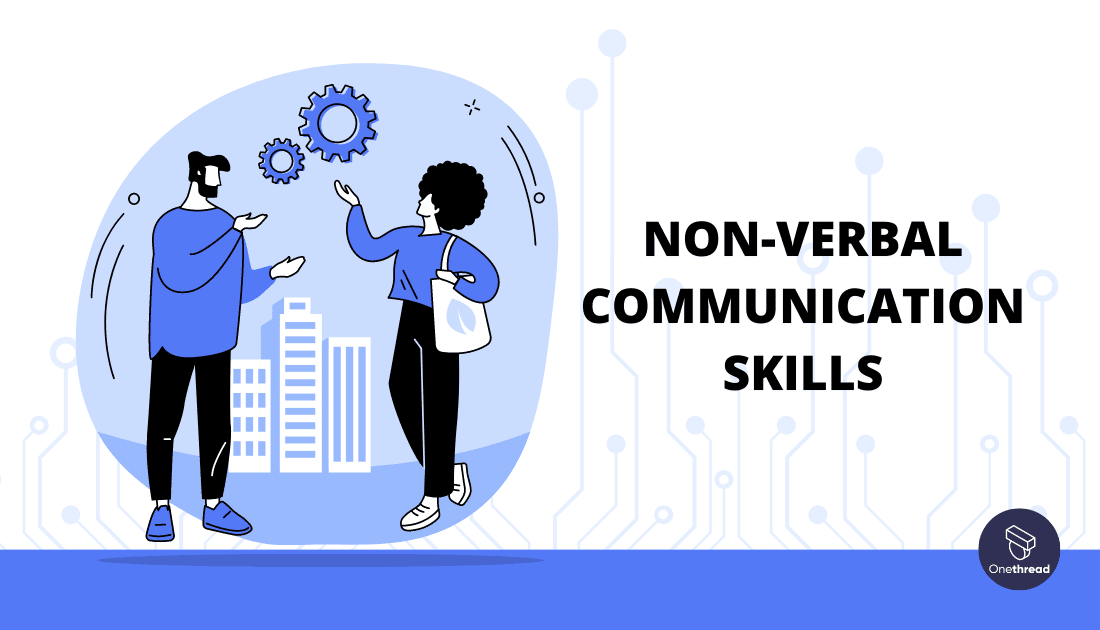Effective communication skills are vital in today’s fast-paced and interconnected world, especially in professional settings.
While verbal communication plays a significant role, Non-verbal communication skills are equally important for conveying messages, establishing trust, and building meaningful connections.
Understanding and mastering Non-verbal communication can significantly enhance your workplace’s success.
In this comprehensive guide, we will delve into the intricacies of Non-verbal communication, exploring its various types and its significant role in the workplace.
We will provide practical tips and strategies to help you confidently improve your verbal and Non-verbal communication skills and navigate different work scenarios.
Whether you’re engaging in face-to-face interactions or remote communication, this guide will empower you to excel in conveying your thoughts, building relationships, and achieving professional success.
Onethread helps professionals improve their Non-verbal communication skills and offers comprehensive training programs to empower individuals to excel in their careers. Discover the transformative power of Non-verbal communication with Onethread today.
Understanding Non-verbal Communication
Non-verbal communication encompasses a wide range of cues that are expressed through gestures, body language, facial expressions, and more. Understanding the significance of Non-verbal communication is crucial for effective workplace communication.
What is Non-verbal Communication and Why It Is Important?
Non-verbal communication refers to the transmission of messages or information without the use of words. It includes body movements, facial expressions, eye contact, and other subtle cues that convey meaning.
Mastering Non-verbal communication skills is essential in the workplace as it enables you to:
- Establish trust and build relationships
- Express authenticity and emotional intelligence
- Enhance workplace performance and productivity
- Open doors to career advancement opportunities
Types of Non-verbal Communication
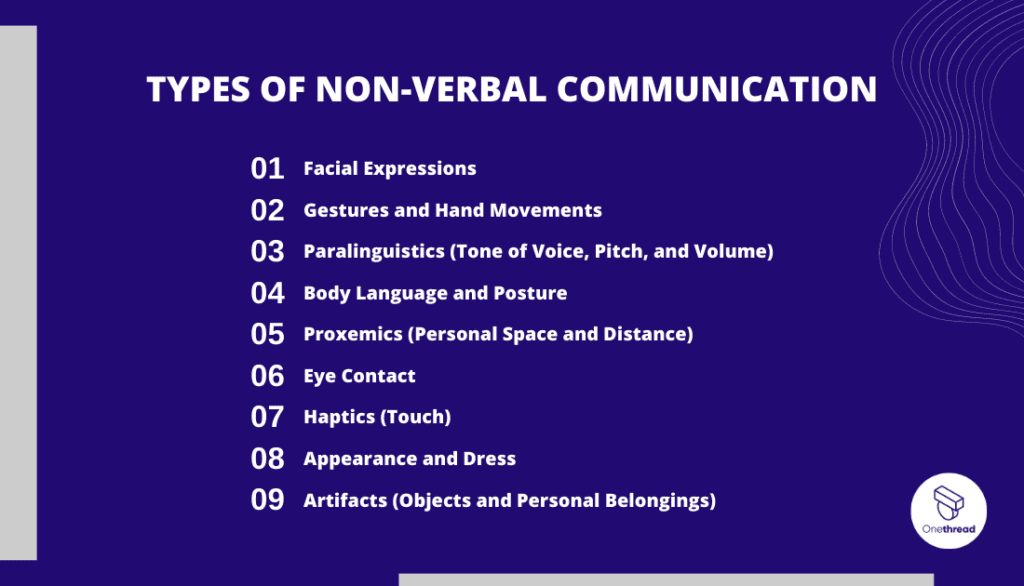
To understand Non-verbal communication comprehensively, let’s explore its various types and their significance in conveying messages effectively.
1. Facial Expressions
Facial expressions are powerful indicators of emotions and attitudes. They can communicate happiness, surprise, sadness, anger, and more. Understanding and correctly interpreting facial expressions is vital for effective communication.
2. Gestures and Hand Movements
Gestures and hand movements can add emphasis, clarity, and meaning to verbal messages. They include hand gestures, pointing, waving, and other movements that complement and reinforce spoken words.
3. Paralinguistics (Tone of Voice, Pitch, and Volume)
Paralinguistics refers to vocal cues beyond spoken words. These include tone of voice, pitch, volume, and speech rate. Paralinguistic cues can convey enthusiasm, confidence, sincerity, and other emotions or attitudes.
4. Body Language and Posture
Body language and posture encompass a wide range of Non-verbal cues, including body orientation, stance, and overall physical demeanor. They can communicate interest, attentiveness, confidence, or discomfort.
5. Proxemics (Personal Space and Distance)
Proxemics refers to the use of space and distance in communication. Different cultures have varying norms regarding personal space, and understanding these norms is essential to avoid discomfort or misinterpretation.
6. Eye Contact
Eye contact is a powerful Non-verbal cue that conveys interest, attentiveness, and sincerity. Maintaining appropriate eye contact during conversations establishes trust and engagement.
7. Haptics (Touch)
Haptics refers to the use of touch as a Non-verbal communication cue. Appropriate touch, such as handshakes or pats on the back, can convey warmth and friendliness. However, being mindful of personal boundaries and cultural differences is crucial.
8. Appearance and Dress
Appearance and dress play a significant role in Non-verbal communication. Clothing choices, grooming, and personal style can communicate professionalism, respect, and attention to detail.
9. Artifacts (Objects and Personal Belongings)
Artifacts are objects or personal belongings that can communicate information about an individual. These include accessories, such as jewelry, watches, or bags, which can reflect personal style, status, or cultural identity.
Now that we have explored the various types of Non-verbal communication let’s delve into its role in the workplace and how it can impact your professional success.
The Role of Non-verbal Communication in the Workplace
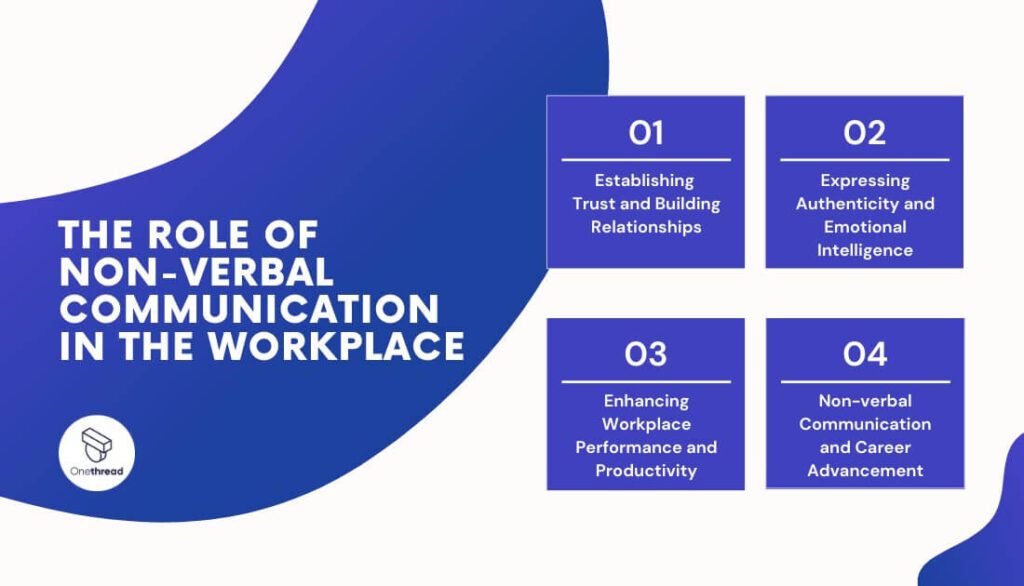
Non-verbal communication is not limited to social interactions; it also plays a crucial role in professional settings. Understanding and utilizing Non-verbal cues effectively can lead to numerous benefits in the workplace.
- Establishing Trust and Building Relationships: In the professional world, trust is paramount. Non-verbal cues, such as maintaining eye contact, displaying open body language, and offering genuine smiles, can help establish trust and build strong relationships with colleagues, clients, and superiors.
- Expressing Authenticity and Emotional Intelligence: Authenticity and emotional intelligence are highly valued in the workplace. Non-verbal communication provides a window into your emotions and intentions. You can convey authenticity, empathy, and understanding by effectively utilizing facial expressions, gestures, and body language.
- Enhancing Workplace Performance and Productivity: Non-verbal cues significantly impact workplace performance and productivity. Clear and confident vocal tone, appropriate body language, and engaged eye contact can enhance communication efficiency, collaboration, and teamwork.
- Non-verbal Communication and Career Advancement: Mastering Non-verbal communication skills can improve your career. Effective Non-verbal communication can positively influence how others perceive you, leading to increased opportunities for promotions, leadership roles, and professional growth.
Now that we understand the role of Non-verbal communication in the workplace, let’s explore how to improve Non-verbal communication skills and positively impact your professional life.
How to Improve Non-verbal Communication Skills: 7 Actionable Tips
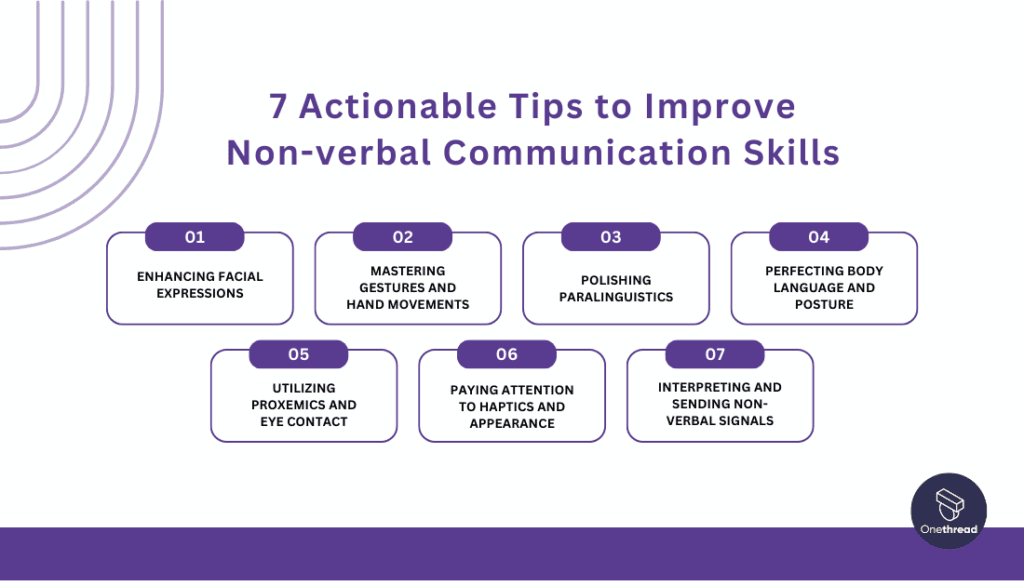
Enhancing your Non-verbal communication skills requires a combination of self-awareness, practice, and continuous improvement. Let’s explore specific techniques to improve different aspects of Non-verbal communication.
1. Enhancing Facial Expressions
Facial expressions can greatly impact how your message is received. Paying attention to your facial expressions can align them with your words and effectively convey your intended meaning.
a. Matching Facial Expressions with Words
Ensure that your facial expressions align with the words you speak. For example, if you’re delivering good news, maintain a genuine smile to reinforce the positive message.
b. Cultivating Positive Facial Expressions
Consciously cultivate positive facial expressions, such as smiles and attentive expressions, to create a welcoming and engaging atmosphere. This can help establish rapport and put others at ease.
2. Mastering Gestures and Hand Movements
Gestures and hand movements can enhance the clarity and impact of your verbal communication. You can effectively convey your message by using gestures purposefully and avoiding excessive movements.
a. Using Hand Gestures Purposefully and Effectively
Use hand gestures to emphasize key points, illustrate concepts, or add emphasis. However, avoid overusing gestures, as excessive movements can be distracting and diminish the impact of your message.
b. Avoiding Excessive Movements and Dramatic Gestures
While gestures can be powerful, striking a balance is essential. Avoid exaggerated or dramatic gestures that may come across as insincere or distracting.
3. Polishing Paralinguistics
Paralinguistic cues, such as your tone of voice and vocal delivery, can greatly influence how your message is perceived. By refining these aspects of your communication, you can convey confidence and engage your listeners effectively.
a. Developing a Clear and Confident Tone of Voice
Practice speaking with a clear and confident tone of voice. Speak audibly, enunciate your words, and avoid mumbling or speaking too softly. This conveys authority and ensures that your message is understood.
b. Emphasizing Key Points and Enhancing Vocal Variety
Emphasize important points by varying your vocal tone and inflection. Use pauses, changes in pitch and volume to add interest and convey the significance of specific information.
4. Perfecting Body Language and Posture
Body language and posture play a significant role in Non-verbal communication. You can convey professionalism and engagement by maintaining correct posture and projecting confidence through your body language.
a. Maintaining Correct Posture and Body Alignment
Stand or sit upright with your shoulders relaxed and your spine aligned. Avoid slouching or crossing your arms; these postures can communicate disinterest or defensiveness.
b. Projecting Confidence and Openness through Body Language
Engage in open body language by keeping your arms relaxed and uncrossed. Face the person you’re communicating with, maintaining eye contact, and nodding to convey active listening and engagement.
5. Utilizing Proxemics and Eye Contact
Proxemics, which involve personal space, appropriate distances, and eye contact, significantly contribute to effective Non-verbal communication. Understanding and utilizing these aspects can enhance your professional interactions.
a. Understanding Personal Space and Appropriate Distances
Be mindful of personal space and cultural norms regarding physical proximity. Respect others’ personal space while engaging in conversations, ensuring they feel comfortable and respected.
b. Establishing and Sustaining Eye Contact
Maintain appropriate eye contact during conversations to convey attentiveness, interest, and sincerity. However, be mindful not to stare excessively, as it may make others uncomfortable.
6. Paying Attention to Haptics and Appearance
Haptics, which involves appropriate touch and attention to appearance and dress, can significantly impact your Non-verbal communication. You can enhance your professional interactions by understanding how touch and appearance influence perceptions.
a. Using Touch Appropriately and Professionally
Be mindful of cultural norms and professional boundaries when it comes to touch. In professional settings, limit touch to appropriate greetings like handshakes and avoid overly intimate or unnecessary contact.
b. Dressing for Success and Professionalism
Pay attention to your attire and grooming, ensuring that it aligns with the expectations of your workplace. Dressing professionally not only communicates respect for the environment but also enhances your personal confidence and credibility.
7. Interpreting and Sending Non-verbal Signals:
Interpreting Non-verbal cues accurately and sending intentional signals is vital for effective communication. You can precisely navigate workplace interactions by developing observational skills and practicing intentional Non-verbal communication.
a. Reading Body Language Cues and Microexpressions
Pay attention to subtle body language cues and microexpressions to better understand others’ emotions, attitudes, and intentions. This skill can help you tailor your own responses accordingly and enhance overall communication.
b. Sending Clear and Intentional Non-verbal Signals
Practice sending intentional Non-verbal signals that align with your verbal message. Pay attention to your facial expressions, body language, and tone of voice to ensure consistency and clarity.
How to Enhance Non-verbal Communication Skills in the Workplace?
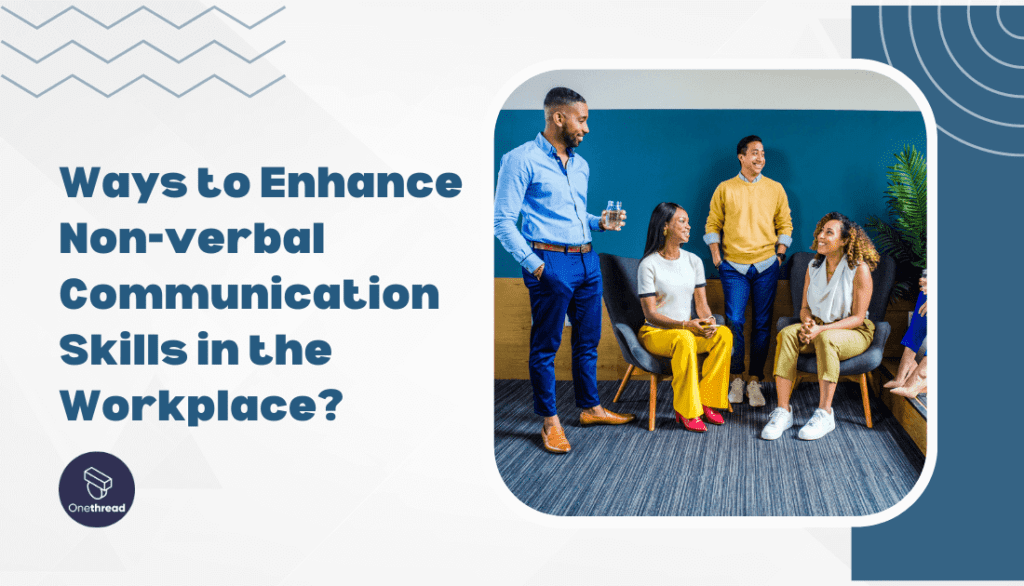
With the increasing prevalence of remote work, it’s essential to adapt and refine Non-verbal communication skills for both virtual and office settings. Let’s explore strategies to enhance Non-verbal communication in different workplace scenarios.
Effective Non-verbal Communication in Remote Work
Remote work presents unique challenges for Non-verbal communication. However, you can still convey your messages effectively and establish meaningful connections with conscious adjustments.
1. Adapting Non-verbal Cues to Virtual Communication
In virtual meetings, ensure that your facial expressions, gestures, and body language are visible within the camera frame. Engage with the camera and maintain eye contact to create a sense of connection with others.
2. Utilizing Appropriate Attire and Backgrounds
Dress professionally, even in remote work settings, to convey respect and maintain a sense of professionalism. Pay attention to your surroundings and choose a clutter-free and appropriate background for video meetings.
Non-verbal Communication Strategies for Office Settings
Non-verbal communication is equally important in traditional office environments. Let’s explore specific strategies to enhance Non-verbal communication skills in face-to-face interactions.
1. Aligning Facial Expressions with Verbal Communication
Ensure that your facial expressions complement and reinforce your spoken words. Smile appropriately, maintain a warm and approachable expression, and mirror the emotions and attitudes of those you’re interacting with.
2. Maintaining Steady and Engaging Tones
Speak clearly and with enthusiasm to maintain engagement during conversations. Vary your tone and use appropriate vocal cues to convey interest and convey your message effectively.
3. Utilizing Body Language to Reinforce Messages
Use body language intentionally to reinforce and emphasize your verbal message. For instance, lean slightly forward to convey attentiveness, nod to show agreement, and use open gestures to welcome conversation.
4. Being Mindful of Misinterpretation
Be aware that Non-verbal cues can be misinterpreted, so pay attention to how your messages are received. Actively listen and ask for clarification when necessary to ensure mutual understanding.
5. Continuous Practice and Improvement
Enhancing Non-verbal communication skills is ongoing. Continuously seek feedback, reflect on your interactions, and practice conscious Non-verbal communication to refine your skills over time.
Why Non-verbal Communication Is Important for Professional Success?

Effective Non-verbal communication skills can significantly impact your professional success. Let’s explore how mastering these skills can positively impact various professional scenarios.
1. Non-verbal Communication During Job Interviews
Job interviews are critical moments where Non-verbal cues can make or break an impression. Paying attention to Non-verbal communication is crucial at every stage of the interview process.
a. Phone Screening and Pre-Interview Non-verbal Skills
Even during phone screenings, your Non-verbal cues, such as tone of voice and engagement, can influence the outcome. Maintain an attentive and positive tone to convey interest and professionalism.
b. Non-verbal Communication During the Interview Process
During face-to-face interviews, project confidence through your body language, maintain eye contact with interviewers and use appropriate hand gestures to reinforce key points. Dress professionally to convey your seriousness about the opportunity.
2. Building Positive Relationships with Coworkers
Effective Non-verbal communication contributes to building positive relationships with colleagues, fostering a harmonious and productive work environment.
a. Making a Good Impression in Team Environments
Utilize Non-verbal cues to create a positive first impression when joining new teams or engaging with colleagues for the first time. Display open body language, maintain eye contact, and demonstrate active listening to foster connections.
b. Developing Rapport and Trust
Non-verbal cues, such as maintaining eye contact, using appropriate touch during greetings, and displaying engaged body language, can help establish rapport and trust with coworkers. This fosters effective collaboration and teamwork.
3. Non-verbal Communication for Leadership and Management
Leaders and managers must effectively leverage Non-verbal communication to inspire and motivate their teams. Mastering these skills can enhance leadership presence and influence.
a. Displaying Confidence and Authority
Leaders must project confidence and authority through Non-verbal communication. Stand tall, maintain steady eye contact, and utilize assertive body language to convey leadership qualities.
b. Inspiring and Motivating Others
Effective Non-verbal communication can inspire and motivate team members. Utilize Non-verbal cues, such as passionate and engaging facial expressions, vocal variety, and open body language, to convey enthusiasm and inspire your team.
How to Use Non-verbal Communication Skills for Success
Mastering Non-verbal communication skills is a powerful tool that can elevate your success in the workplace. How you present yourself, physically and emotionally, can influence how others perceive and respond to you.
One key aspect of Non-verbal communication is body language. Pay attention to your posture – stand tall, with your shoulders back and head held high. This conveys confidence and professionalism. Additionally, maintain eye contact during conversations to show attentiveness and engagement.
Facial expressions are another important component of Non-verbal communication. A genuine smile can create a positive impression and foster connections with colleagues or clients. Conversely, frowning or scowling might be perceived as negative or unapproachable.
Your tone of voice also plays a significant role in conveying messages effectively. Speak clearly and confidently without being overly aggressive or passive. Adjust your tone accordingly based on the situation – assertive when necessary but always respectful.
Dress appropriately for the workplace as it reflects your professionalism and level of respect for the environment. Take cues from company culture while maintaining an individual style that aligns with your personal brand.
Be mindful of gestures and mannerisms that may distract from effective communication, such as fidgeting or excessive hand movements. Practice active listening by nodding appropriately to show comprehension while avoiding overuse that could indicate impatience.
By consistently honing these Non-verbal communication skills, you will enhance your professional image and establish yourself as an influential communicator in any workplace setting.
Conclusion
Mastering Non-verbal communication skills is essential for workplace success. By understanding the various types of Non-verbal communication, recognizing their significance, and continuously improving your skills, you can enhance your professional interactions, build strong relationships, and create opportunities for career growth.
[Non-verbal communication skills] are a fundamental aspect of workplace communication. Developing and mastering these skills can significantly enhance your professional success and positively impact your work relations.
So, start implementing the strategies and techniques outlined in this comprehensive guide and unlock the power of Non-verbal communication in your professional journey.
FAQs
Q: What are the most important Non-verbal communication skills for workplace success?
A: There are several key skills that can greatly contribute to your success Non-verbal communication skills in the workplace.
These include maintaining eye contact, using appropriate facial expressions, having good posture and body language, and using hand gestures effectively. Being aware of your vocal tone, volume, and personal space boundaries is also important.
Q: How can I improve my Non-verbal communication skills?
A: Improving your Non-verbal communication skills takes practice and self-awareness. Start by observing others who have strong Non-verbal communication skills and try to emulate their behaviors.
Pay attention to how you present yourself physically – stand tall with confidence, make deliberate gestures, and maintain a relaxed yet engaged facial expression. Practice active listening techniques to show interest and engagement in conversations.
Q: Can Non-verbal cues convey different meanings across cultures?
A: Yes, absolutely! Non-verbal cues can vary significantly across different cultures. For example, direct eye contact may be seen as respectful in some cultures but disrespectful or confrontational in others.
Similarly, certain hand gestures or physical proximity may have different connotations depending on the cultural context. Educating yourself about cultural norms before engaging with individuals from diverse backgrounds is essential.
Q: How does technology impact Non-verbal communication at work?
A: Technology has revolutionized how we communicate at work but also poses challenges to effective Non-verbal communication.
With increased reliance on virtual meetings or email exchanges rather than face-to-face interactions, important aspects of Non-verbal cues such as body language or vocal tone may be missed or misinterpreted.
It’s crucial to adapt our use of technology by being mindful of our written communications’ clarity while seeking opportunities for video conferencing whenever possible.
